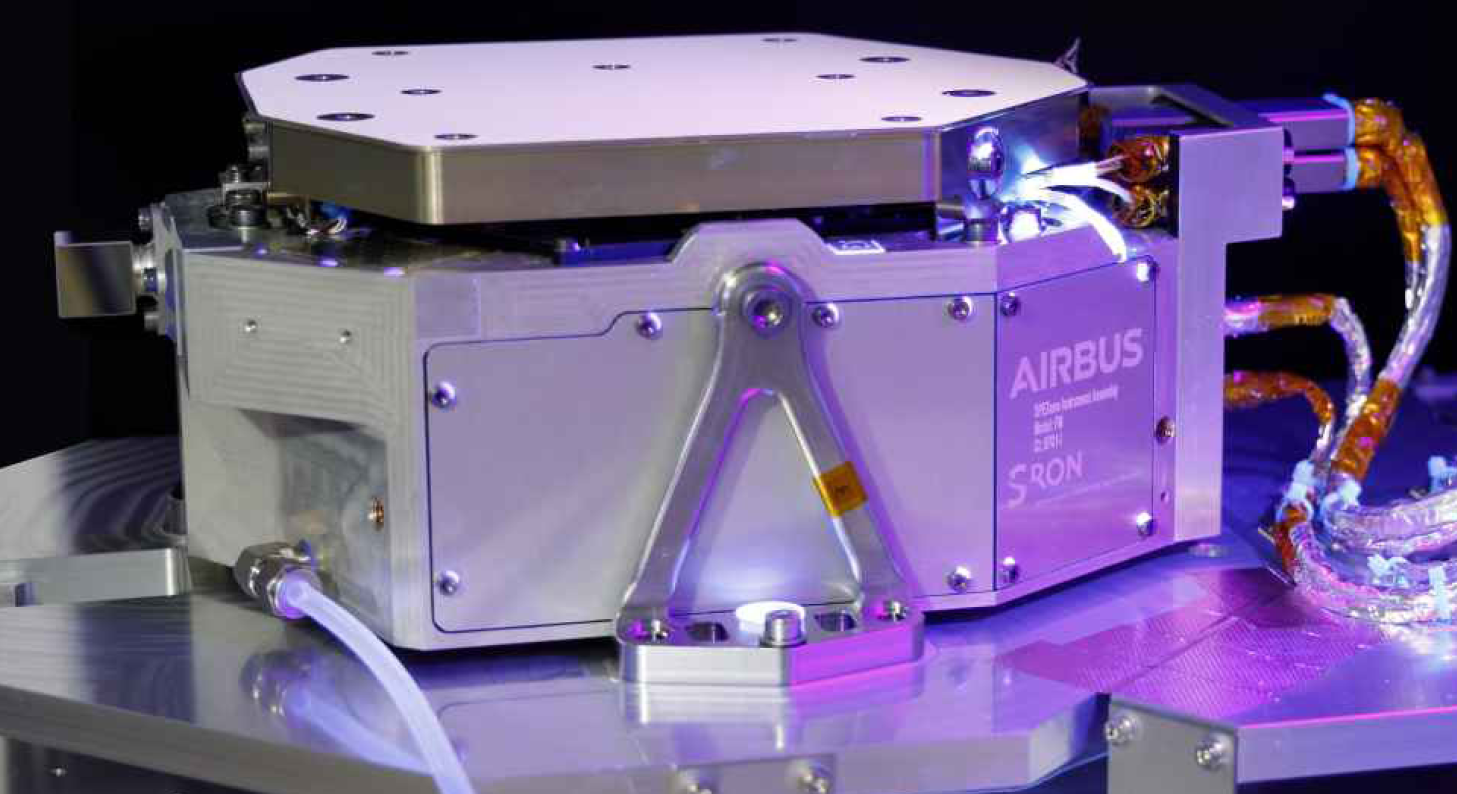SPEXone
From early 2024, the compact, aerosol measurement and tracking instrument SPEXone will look at our planet’s atmosphere from an altitude of about 700 km for a period of roughly seven years. The instrument is embarked on NASA’s PACE (Plankton, Aerosol, Cloud and ocean Ecosystem) mission, which will study various factors that affect life on Earth (sea, climate and air). Thanks to SPEXone’s design, including a unique combination of spectral modulation and multi-angle polarimetry in a single instrument, it will provide snapshot and highly accurate measurement of the linear polarisation of atmospheric back-scattered light, unlocking best-in-class aerosol characterisation. This way, detailed insights become available to effectively address air pollution and climate change.
Aerosols, a great risk to our health
Aerosols, depending on their size and type, have important effects on air quality and health. The World Health Organization (WHO) has revealed that air pollution is one of the greatest environmental risks to health. It estimates that in- and outdoor air pollution caused 7 million premature deaths annually, and that more than 99% of the global population lives in areas where the level of outdoor air pollution is too high.
Where today aerosols are mostly classified by size only (PM10, PM2.5), SPEXone measurements add important properties of aerosols such as index-of-refraction, shape, Single Scattering Albedo (SSA) and Angström exponent, to allow classification into different types and sources, such as smoke, dust, urban-industrial and marine aerosols.
Identifying, classifying, and quantifying these harmful aerosols will benefit public health significantly. When natural and anthropogenic aerosols are distinguished it is possible to take evidence-based, targeted measures to address such aerosols, thereby improving the quality of the air we breathe.
Unravelling the impact of aerosols
Aerosols also feature in the atmosphere’s radiation balance and hence play a role in global warming. However, of all contributions to the radiation balance the effect of aerosols is the most unclear. Accurate characterisation of aerosols is therefore indispensable for further understanding and addressing global warming.
SPEXone obtains detailed aerosol properties by measuring – with unprecedented accuracy – the colour-resolved polarisation of light that is being scattered by the Earth atmosphere in different directions. This makes the output very well suited to classify aerosols and identify their emission sources. As a result, SPEXone delivers important information for climate and air quality studies.
For a more detailed article on aerosols as physical drivers of climate change, click here.
SPEXone obtains detailed aerosol properties by measuring – with unprecedented accuracy – the colour-resolved polarisation of light that is being scattered by the Earth atmosphere in different directions. This makes the output very well suited to classify aerosols and identify their emission sources. As a result, SPEXone delivers important information for climate and air quality studies.
Key features of SPEXone:
- Snapshot measurement of the full linear polarisation state, providing excellent temporal registration without moving parts.
- Single integrated module performing all measurements for multi-angle polarimetry:
- Five different observation zenith angles
- Full wavelength-resolved radiometry
- Full wavelength-resolved degree of linear polarisation
- Full wavelength-resolved angle of linear polarisation
- Flexible detector module firmware, reducing data processing demands on platform control computer.
- A compact and robust design.
- Possibility to mount it on spacecraft side wall or on nadir deck.
Figure 1: Opto-mechanical assembly of SPEXone, with thermal radiator at the top
The first SPEXone is one of the three instruments on board the NASA PACE mission that is schedule for launch in the first quarters of 2024. A second SPEXone is currently being tested and calibrated for another mission which has a slightly different swath and ground solution. The key parameters for the SPEXones produced to date are given below.
click to view
Innovative technology
In one instrument SPEXone comprises the following elements:
- Five telescopes to observe five different scattering geometries simultaneously.
- SPEX polarisation optics that map the linear polarisation state of the incoming light as two modulations onto the spectral radiance.
- An imaging spectrometer to spectrally resolve the signal.
Figure 2: exploded view of the SPEXone opto-mechanical assembly, showing the nested nature of the instrument
With all its features a single snapshot image of SPEXone contains simultaneous and complete information about spatially resolved, spectral radiance, and about the spatially resolved, wavelength-dependent degree and angle of linear polarisation, for five pushbroom swaths, fanned-out in the flight direction. In a single overflight this results in five different observation geometries for each point on the ground, with that providing all information to determine aerosol concentration, type, and various microphysical properties.
The unique telescope design of SPEXone enables multi-angle polarimetry in a single compact module, while the SPEX spectral modulation principle ensures the high polarimetric accuracy and excellent co-registration, which are necessary for reliable aerosol retrieval and characterisation. Below the polarimetric SNR and radiometric SNR in function of wavelength is given.
Figure 3: the SPEXone polarimetric SNR and radiometric SNR in function of wavelength
Heritage
SPEXone is the next stepping stone in a long Dutch tradition of the development and construction of atmospheric measuring instruments. It builds upon the previous successes of Earth observation instruments such as Sciamachy, OMI and Tropomi. SPEXone is Tropomi technology made fit for small satellites. The data from all these instruments enable high-quality scientific research and are used for many applications in our everyday lives.
SPEXone partners
SPEXone is a public-private initiative under scientific lead of SRON, funded by the Netherlands Space Office (NSO), the Netherlands Organization of Scientific Research (NWO), SRON and Airbus Netherlands. A joint team of Airbus NL and SRON realised SPEXone, with expert support from TNO. The Dutch consortium acknowledges NASA for hosting SPEXone on their PACE observatory as a partnered payload.






Share